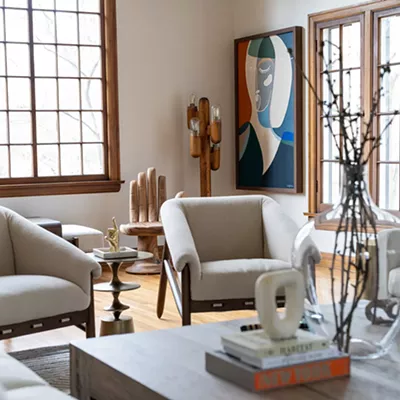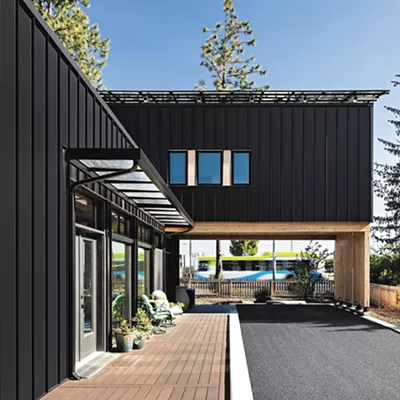Inside a small, dimly lit room, fine snow-white salt covers the walls, ceiling and floor. In the corner, two Himalayan crystal salt lamps emit a gentle orange glow. Over faint ambient music, a generator hums, dispersing microscopic salt particles into the air. There are three lounge chairs, where patrons can kick back, close their eyes and inhale. A box of Kleenex is conveniently within reach.
“They’ll be sitting in there and be blowing up a storm after about half an hour. They’re draining. They’re like Niagara,” says Laura Viherlahti, owner of the aptly named Saltroom of Spokane. “They don’t have blocked sinuses when they walk out.”
For those suffering from a spate of allergies, persistent cough, plugged nose or scratchy throat, Viherlahti and her small but devoted clientele say breathing a little sodium chloride may help clear away pesky symptoms.
Known as ‘halotherapy’ (‘halos’ is the Greek word for salt), the practice has been popular in Central and Eastern Europe for decades, although it’s virtually unknown in the United States. Man-made salt chambers, designed to replicate conditions in underground salt caves, have been cropping up across the country in recent years, in cities like Los Angeles, New York and Orlando, Fla.
Scientific evidence in English-language journals supporting halotherapy is sparse, but that hasn’t stopped respiratory sufferers from trying it out.
Halotherapy might relieve some respiratory ailments because “salt has a high osmotic pressure,” explains Dr. Norman Edelman, chief medical officer of the American Lung Association. “It will draw water out of the airways of the lungs and liquefy the mucus... People will be able to cough it up better.”
But many physicians, Edelman included, are skeptical of the benefits of breathing salty air. The Centers for Disease Control and Prevention has never researched halotherapy. The National Institute of Health hasn’t heard of it, and the Food and Drug Administration hasn’t approved it.
“Certainly that sort of thing would need to be done with a lot of supervision,” says Dr. Teal Hallstrand, a pulmonologist at the University of Washington who worries that exposure to a high concentration of sodium might cause asthma patients’ airways to constrict and trigger worse symptoms. “I would advise them against it,” he says.
Back at the Saltroom of Spokane, Viherlahti dismisses her detractors: “It’s symptom management,” she says. “We’re not claiming to cure anything… This is just another alternative to help with the condition that’s there.”
Outside the salt chamber, she measures half a cup of fine pharmaceutical-grade salt and pours it into a halo generator, a stainless-steel blockish contraption with a knob and several switches, mounted to the wall. Small blades inside the generator pummel the salt until it’s tiny — less than five microns — before being blown into the room as a mist.
Viherlahti guesses her clients inhale the equivalent of two shakes of salt while spending an hour in the salt room.
“It’s like being at the ocean,” she says. “I always tell my clients that if they are not allowed to go to the beach for some reason, then they shouldn’t come here. So it’s really not much salt.”
A single 60-minute session in the salt room costs $25, or $85 if you’d like a massage from Sabrina Caldwell, the spa’s licensed massage therapist. But Viherlahti recommends visiting several times in a row; she charges $100 for five sessions and $150 for 10. (In case you’re wondering, insurance doesn’t cover it.)
Viherlahti opened the Saltroom in 2006, marketed under the name Salt Crystal Cottage. “Everybody thought it was some kind of voodoo hoo-hoo, something weird,” she says.
She got the idea from her Finnish father-in-law, a serial entrepreneur who has dabbled in ergonomic furniture, homeopathic magnets and therapeutic peat. After visiting a salt room at a children’s hospital in St. Petersburg, Russia in the 1980s, he developed a line of halo generators and started selling them to spas, hotels and medical facilities throughout Europe.
Business at the Saltroom “has been really slow,” and Viherlahti, who recently has devoted herself full-time to the enterprise, is hoping to change that. Although her clientele is small, it’s dedicated and effusive.
Jamie LaRoque of the South Hill gets a massage at the Saltroom every week. Ever since she started visiting regularly, she says she’s had fewer sinus migraines. A chronic allergy sufferer, she “can breathe a lot better.
“Immediately, my nose and my sinuses completely cleared — not even just for the couple hours afterward,” LaRoque says. “It’s been night and day for me… I can blow my nose and everything’s gone.”



















